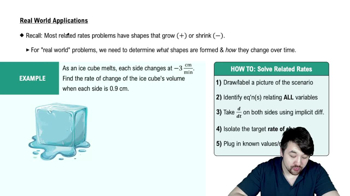Table of contents
- 0. Functions7h 52m
- Introduction to Functions16m
- Piecewise Functions10m
- Properties of Functions9m
- Common Functions1h 8m
- Transformations5m
- Combining Functions27m
- Exponent rules32m
- Exponential Functions28m
- Logarithmic Functions24m
- Properties of Logarithms34m
- Exponential & Logarithmic Equations35m
- Introduction to Trigonometric Functions38m
- Graphs of Trigonometric Functions44m
- Trigonometric Identities47m
- Inverse Trigonometric Functions48m
- 1. Limits and Continuity2h 2m
- 2. Intro to Derivatives1h 33m
- 3. Techniques of Differentiation3h 18m
- 4. Applications of Derivatives2h 38m
- 5. Graphical Applications of Derivatives6h 2m
- 6. Derivatives of Inverse, Exponential, & Logarithmic Functions2h 37m
- 7. Antiderivatives & Indefinite Integrals1h 26m
- 8. Definite Integrals4h 44m
- 9. Graphical Applications of Integrals2h 27m
- 10. Physics Applications of Integrals 2h 22m
4. Applications of Derivatives
Related Rates
Problem 3.11.8
Textbook Question
At all times, the length of the long leg of a right triangle is 3 times the length x of the short leg of the triangle. If the area of the triangle changes with respect to time t, find equations relating the area A to x and dA/dt to dx/dt.
 Verified step by step guidance
Verified step by step guidance1
Start by expressing the relationship between the lengths of the legs of the triangle. Let the short leg be x, then the long leg is 3x.
The area A of a right triangle is given by the formula: A = (1/2) * base * height. Here, the base is x and the height is 3x, so A = (1/2) * x * 3x.
Simplify the expression for the area: A = (3/2) * x^2.
To find the relationship between dA/dt and dx/dt, use the chain rule for differentiation. Differentiate A with respect to t: dA/dt = d/dt[(3/2) * x^2].
Apply the chain rule: dA/dt = (3/2) * 2x * (dx/dt), which simplifies to dA/dt = 3x * (dx/dt). This equation relates the rate of change of the area to the rate of change of the short leg.
 Verified video answer for a similar problem:
Verified video answer for a similar problem:This video solution was recommended by our tutors as helpful for the problem above
Video duration:
2mPlay a video:
Was this helpful?
Key Concepts
Here are the essential concepts you must grasp in order to answer the question correctly.
Area of a Right Triangle
The area A of a right triangle can be calculated using the formula A = (1/2) * base * height. In this case, the base can be considered the short leg (x) and the height the long leg, which is 3x. Therefore, the area can be expressed as A = (1/2) * x * (3x) = (3/2)x^2.
Recommended video:

Estimating the Area Under a Curve with Right Endpoints & Midpoint
Related Rates
Related rates involve finding the relationship between the rates at which two or more quantities change. In this problem, we need to relate the rate of change of the area (dA/dt) to the rate of change of the short leg (dx/dt). This is typically done using implicit differentiation with respect to time.
Recommended video:

Intro To Related Rates
Chain Rule
The chain rule is a fundamental principle in calculus used to differentiate composite functions. When applying the chain rule in this context, we differentiate the area A with respect to time t, leading to dA/dt = (dA/dx)(dx/dt). This allows us to express how the area changes as the length of the short leg changes.
Recommended video:

Intro to the Chain Rule
Related Videos
Related Practice





